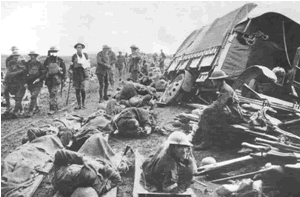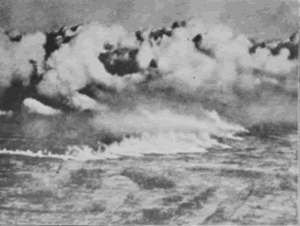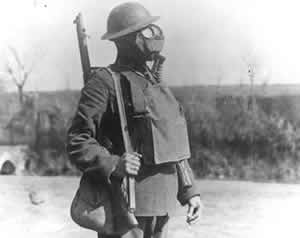Ypres
Reference to "Chemical and Biological Warfare" by L.B. Taylor and C.L.Taylor 1985

Without warning a round of deafening shelling commenced by the Germans from the position in the south. Seconds later a greenish cloud, as seen on the right, was noticed by the unsuspecting soldiers, a few hundred metres in front of their trenches, quickly drifting towards them. Troops quickly fell into a state of confusion as the cloud reached the first allied soldiers.

The gas that caused this horrific devastation was chlorine. After waiting for the right wind conditions the Germans released 160 tons of liquid chlorine. Once in the gas form it is impossible to control the cloud that is formed. Chlorine burns the lining of the throat and lungs causing severe bouts of coughing which often proved fatal. In severe cases, as happened at Ypres, thick green fluid develops in the lungs causing victims to choke to death.
After the devastation, 5,000 lay dead, 10,000 were injured and 7 kilometres of the Allied line had collapsed. However the Germans were not prepared for such a significant effect of their new weapon and failed to capitalise on its devastation.
Two days later, again at Ypres, the Germans launched a second gas attack against Canadian troops called in to seal the gap created by the first gas attack. Once again without adequate protection the effects were similar to those two days earlier.

During the early twentieth century military leaders considered chemical warfare to be an indecent and inhumane form of warfare. Not only did it cause agonising death and long lasting horrible injuries but it did not discriminate against civilian targets. The Hague treaty of 1899 forbade "the use of projectiles the sole object of which is the diffusion of asphyxiating and deleterious gases."
The Allied forces chose to
respect the treaty for three reasons:
- they feared reprisals from the enemy;
- the Germans were advanced in the development of chemical weapons and
the Allies were not convinced they could match them.
- they believed that the enemy would not initiate this illegal means
of warfare considering the strong terms of the treaty.
Fritz Haber, a Nobel Prize winner, devised the plan to release chlorine gas into the Allied trenches. On December 19, 1915, Ypres was the site for another German chemical attack, this time using phosgene. Once again Haber was behind the development of this deadly gas. Phosgene is many times more effective than chlorine and works by inflaming the lining of the respiratory tract and causing death by asphyxiation. Unlike chlorine phosgene is almost odorless and colorless and therefore harder to detect.
By the end of 1916 both the Allied and German forces were routinely using chemical warfare. As this type of warfare became routine so did the protective measures such as the gas mask became more sophisticated to the point that it negated the effect of chemical attacks.